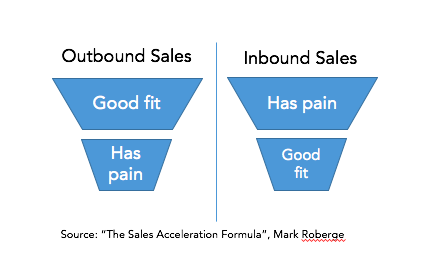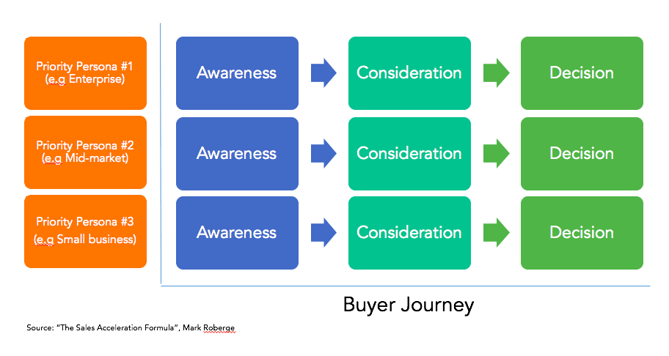So, you’ve been executing your inbound marketing strategy well, creating helpful and engaging content, distributing that content on social media and the leads have begun to flow into your database. You’re a hero! So what next? How are you going to convert all of these leads into customers? Should you just hand them all over to sales and let them figure it out? Unfortunately, not. Gone are the days where you can just throw a whole bunch of leads over the fence to sales. In fact, having a sales person call all your inbound leads with the same standard elevator pitch is the kiss of death for an inbound lead. So please don’t waste all that hard work that’s gone into creating effective inbound marketing by not aligning your entire inbound process.
Inbound leads are not the same as outbound leads
First things, first. I know the team are excited to get their hands on all of these new leads, but inbound leads are not the same as traditional outbound leads. This diagram from Mark Roberge’s book The Sales Acceleration Formula most clearly describes the difference between traditional leads and inbound leads.
 In the outbound model the sales team starts with a list that they’ve rented or purchased that meets their good “fit” requirement (i.e. organisations of 1,000 or more employees, in the right industry and location with the right job title) and then marketing is told to use that list as much as possible with direct mail, email, paid advertising and telemarketing. The small percentage of people who actually respond to this will have some type of pain, but it’s a hard slog, expensive and not very effective.
In the outbound model the sales team starts with a list that they’ve rented or purchased that meets their good “fit” requirement (i.e. organisations of 1,000 or more employees, in the right industry and location with the right job title) and then marketing is told to use that list as much as possible with direct mail, email, paid advertising and telemarketing. The small percentage of people who actually respond to this will have some type of pain, but it’s a hard slog, expensive and not very effective.
In the inbound model, the leads have found your content via Google search or social media. In many cases these inbound leads have the pain (why else would they have downloaded your eBook?) but may never be a good fit for your company’s product or service. They may never buy from you and that’s OK. It does not mean that inbound has failed, it just means that the leads needs to be handled differently.
This is where marketing is playing an increasing role in the selling process, to nurture these leads with content and work with sales to identify the characteristics of a “good fit” or sales qualified lead (SQL) and work that into how you continue to nurture your inbound leads.
I repeat do not pass all the leads to sales
If you pass all the inbound leads directly to sales, including the unqualified ones, who are never going to be a good fit for your organisation, you run the risk of the sales team coming to the quick conclusion that all inbound leads are no good. Why? Because they’ve spent time and effort calling and “pitching” to the entire list of leads, when really there were only a few that were worth the sales person calling.
If you improve the process and only hand over the good fit leads, then the sales team will think that marketing is wonderful and continue to support marketing’s investment in inbound tactics.
Don’t overcomplicate the lead nurturing process.
Now that you have a generous supply of inbound leads, the next step is to look at your nurturing process. There are many different marketing automation systems around, with different recommendations for lead scoring. However, I’ve found that lead scoring can easily end up being based on a very complicated set of factors that make it even more difficult to know when is the best time to pass the lead to sales.
So, instead of lead scoring perhaps look at your buyer personas and create a matrix with sales about when each type of lead should be handed to sales and which point in time in their buying journey. A simple buyers journey can be mapped into the following three broad categories or buyer stages.
- Problem Education or Awareness Stage
- Solution Research or Consideration Stage
- Solution Selection or Decision Stage
Depending on how important the buyer persona is to the organisation and when they arrive in the optimal “buyer stage” is when they should be handed over to sales. For example in some organisations anyone who is the “Enterprise” buyer persona target should immediately be handed over to sales.

At each buyer stage there needs to be a content trigger for each persona, for example;
- Awareness stage (white papers, eBooks)
- Consideration stage (case studies & ROI tools)
- Decision stage (free trials, consultations, demonstrations)
Download the content mapping template for more information on mapping your content to the buying journey.
Do not use the same elevator pitch on all of them
In the above example, let’s say the Enterprise lead downloaded a piece of content, your sales team should be immediately notified that this happened so that they can follow up directly… BUT and it’s a big BUT. The reps need to have a look at the contact record first, do some research on LinkedIn and follow up with context, curiosity and helpfulness not the standard elevator pitch. The company may be qualified, but not the contact, but this doesn’t mean that it’s a bad lead. Say for example it’s an intern downloading content assets. Obviously they aren’t the decision maker, but why are they downloading the content? Are they interested for themselves or did someone ask them to research this topic? Make sure you tailor your approach based on the content they have show interest in, who they are in the organisation and take baby steps.
Baby steps
There is a guest post on this blog about taking baby steps with leads. Just because someone has downloaded a piece of content does not mean that they are going to become a customer. In this online era, people have their guard up, they don’t want to be sold to, or conned, but they do want to engage with helpful people. So be helpful, but take small steps. Don’t blast straight through to what you want them to do next, like book a demo or a phone call, who cares about you? Ask them a simple question, such as “Did it download OK?”. This is not salesy, it is simple and more often than not generates a reply… and once a reply has happened, then a conversation can begin, but most importantly the conversation will be a real, person-to-person conversation and not a prospect to vendor guarded conversation.
If you have more questions on this topic, I’m hosting a live webinar on 15th October with Rick Roberge and Carole Mahoney. Register here and even if you can’t attend live I’ll send you a copy of the recording.


